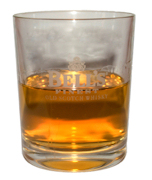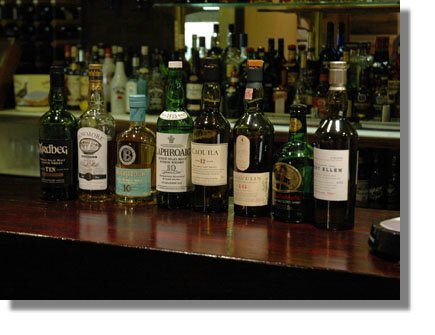

Whisky Connoisseur
Arthur J A Bell
How To Taste


Whisky Connoisseur
Arthur J A Bell
How To Taste

Photo of Islay Whiskies via Wikimedia
The real enjoyment of Scotch whisky is very much a personal matter and highly subjective. Within these tasting notes the subject is accessed so that readers can describe the aroma, bouquet and the taste of Scotch whisky, whilst giving a greater understanding of the many descriptive terms employed in the industry.
HOW TO TASTE
The question is often posed: Do I taste at bottle strength or, do I add a little water? The answer is to take advantage of the situation and sample both ways, especially with cask strength malts, when the wood and maturation characteristics will be most obvious at the 'neat' strength. Then by adding a measure of water, the full aroma of the whisky will be witnessed.A word of caution, the quality of water is of paramount importance to tasting enjoyment. Sparkling and soda waters are not compatible with whisky as they tend to react and divide the complexity of flavours, making the finest whisky taste somewhat coarse... An experiment worth trying only once.
PERSPECTIVE
It must be understood that the flavour congers in Scotch whisky account for less than 0.5% of the total composition of the whisky. It will therefore be realized that the sensitivity of human taste buds are quite extraordinary in their perception of flavours that is the compound of smell and taste.One other sense employed in our assessment of life is the sense of sight. So much of our well-being and enjoyment on this earth is attributed to what we see - if it looks attractive then it may well taste good. Colour, clarity and general form whet the appetite for more interest and in the case of whiskies - tasting proves satisfaction. How often in every day life do we make decisions on sight or smell alone, without recourse to tasting, when what we see or smell is not agreeable!
FLAVOUR SPECTRUM
Although there are well defined differences in flavour between what is insipid and what pleases, the difference between what is good and what is excellent is not so easily defined. The purpose here of the flavour language is to quantify the subtle difference in perception by meaningful descriptions related to the process terminology in universal usage with the Scotch Whisky Industry.NOMENCLATURE OF FLAVOUR
1. PEATY
The origins of Scotch whisky flavour owe much to the basic elements of EARTH, FIRE and WATER. PHENOLS producing the peat flavours in whisky are conceived in all three sources: Peat dug from the earth are used to dry the BARLEY corn; Fire utilized to burn the peat to kilm the barley releases smoke; thirdly fire used in the cooperage to shape the BARRELS releases wood phenols to the maturing whisky; finally WATER utilized to soak the barley originates from Highland burns passing over granite and PEAT outwith the distillery.Scotch MALT distilleries are always founded near plentiful water which is used in crafting the native spirit. The seaside distillery locations assimilate the sea air influencing the SEA TANGLE - IODINE - MEDICINAL flavours in malt whisky, so common with the Islay and West coast malt whiskies.
The combination of the sea soaked peat moss and fire to dry the barley also induces a KIPPERY flavour to some coastal malt whiskies, especially those on the Islands and in Campbeltown.
At the opposite end of the Phenolic Spectrum are the less intense peated flavour notes termed BIRCHY OR MOSSY, as with the birch trees of Old Caledonia. These lesser malt whisky flavours verge on the ALDEHYDIC or LEAFY notes which converge into the WOOD flavour category to become BLAND perhaps?
A trace of peat in all Scotch whisky is desirable and contributes towards the flavour complex. The more heavily peated malt whiskies are an acquired taste of the connoisseur and can be very refreshing to the taste buds, but in blends a little goes a long way.
2. ESTERY The term is applied collectively to the more pleasant FRAGRANT - FRUIT FLORAL aromas in Scotch. These contribute significantly towards the flavour DEFINITION of the whisky. Included in this category are the HONEYED - PEAR DROPS fragrance witnessed at the top quality Pot Still whiskies of moderating antiquity.
The ESTERS in malt whisky are distilled by design in the Copper Still and are the most important faction of the new spirit. The basis of the maturation process in cask is the ESTERIFICATION of the spirit - ALCOHOL oxidizes to ALDEHYDES, thence ACIDS; the ALDEHYDES further unit with ALCOHOL, to form ACETALS. This process, know as maturation, is continuous and dependent upon warehouse conditions - damp, earth floors & stone-wall construction are the ideal recipe for good barrel ageing and quality Scotch whisky.
Estery flavours in moderation are desirable in good Scotch whisky. However too much can confuse the taster with "Jamaica" Rum or "Old Cognac" like connotations.
3. BRACKENISH
The Scotch whisky flavours described as BRACKENISH or DRY originate in the production process and from the cask used to age the spirit. They are at the opposite end of the Scotch whisky flavour spectrum to ESTERY.The sugars available from the malted barley (graphic of barley on the right is via Wikimedia) are all utilised by the yeast activity during the fermentation; thus the new spirit is without sugar - basically DRY. In the Low Wines distilling cycle of Scotch malt whisky ESTERS are produced during the early spirit collection and later, as the alcoholic strength reduces, the FEINTS components distill to complete the fraction of collectible spirit. Good distillation practice minimize the feints components, (termed FUSEL in grain whisky distilling, but rapid heating of the Pot Still can contaminate the spirit and contribute undesirable flavours, beeswax - earthy - stale - dry to the final Scotch whisky spirit.
Feints odours are readily recognised in the new make Scotch whisky spirit (just off the still) and relate on the flavour chart to the flavours descriptors - leathery - tobacco ash - sweaty - stale fish which on maturation in cask are modified by the barrel extracts and oxidation to the EARTHY - DRY associations. Scotch whisky ageing in oaken casks relies very much upon the quality and the origin of the oak, the years in the cask prior to bottling and the initial quality of the spirit. This combination of factors is the perfect medium to enhance spirit quality. However the same conditions may also marginally spoil the product flavours towards an EARTHY - DRYNESS. Excessive barrel ageing relative to spirit quality lends to the whisky a STRAWLIKE oxidized flavour, predominant in the lighter textured malt whiskies at ten plus years in the wood.
It will therefore be appreciated the BRACKENISH - DRY flavour associations above trace in Scotch whisky are not really desirable in the quantity complexity.
4. BLAND
The quieter style of Scotch whisky produced from unpeated BARLEY are relatively light in characteristics and dependent upon the ESTERY definition of flavour, may be categorized "BLAND".In production, the shape of the Pot still influencing the new spirit character and the type of maturation cask can also contribute towards the BLAND style in whisky. In particular the Speyside Malts may be described as slightly - oily - SUGAR - OILY - WATER and with barrel aging may produce the BUTTERY - LINSEED -almost WAXY taste of typical BLAND Scotch whiskies. This group of flavour components also included the HONEY - VANILLA connotations in the flavour spectrum which are often termed MELLOW. Mellowness makes a significant contribution to Scotch whisky when combined to form a distinctive style, but bland whiskies are really uninspiring and without traditional Scotch whisky character.
5. WOOD FLAVOUR (Barrel Ageing)
The subtle flavours producing the unique Scotch whisky character are a combination of the BARLEY, the distillery LOCATION and the STILL design, all refined by time in the WOODEN CASK. Many years in the BARREL in a dark damp warehouse orchestrate the native spirit through a complex classical melody of developments in flavour enhancement.Over the decades, OAK wood has proven itself supreme for ageing potable liquors, because it is semi permeable and allows the diffusion of alcohol and water through the thickness of the barrel STAVE promoting minimal evaporation on the wood surface to the extent of 2% per annum in Scotland. This is the slow process of maturation so essential to product quality.
By tradition, Scotch whisky is not matured in a NEW cask as with Brandies (Cognac and Spanish) and Bourbon, which historically have benefited from the new oak extracts. The associated CARAMEL bitterness of the new oak due to excess TANNINS, LIGNIS, PHENOLS and RESINS are rarely present and are not appreciated by the connoisseur of aged malt whisky.
Within the Scotch whisky COOPERAGE two distinctive types of white oak are employed to fashion barrels from America or from Spain. The AMERICAN oak (Quercus ALBA) contains less than half of the total wood extract found in the EUROPEAN oak (Quercus ROBUR). The Bourbon Whiskey industry uses solely American oak suitably charred to promote the carmelisation of the wood sugars, so essential to bourbon character. This pre-treatment of the American barrels with fire and spirit has become acceptable to the Scotch distiller. The alternative and much sought after source of pre-used cask is JEREZ Spain which offers both American and European oak casks having previously contained SHERRY wines.
It will be appreciated, as with all things in life, the expected enhancement of spirit quality within the cask does not always materialize and those SULLIED barrels are discarded, no matter how slight the imperfection. A similarity exist between CORKS in wine or whisky and wood for casks, that the SOURISH MUSTY - DANK flavours of bad wood spoils the barrel content.
FLAVOUR TERMS
TERM DESCRIPTION
PEATY
Phenols: Tar Like
Smokey: Wood Smoke
Sea Tangle: Sea Shore/Sea weed
Iodine: Sea Breeze
Medicinal: TCP
Kippery: Smoked Fish
Birchy: MossyESTERTY
Fragrant: Rose Scented
Fruity: Orange/Lemony
Floral: Carnations
Honeyed: Blossom Honey
Pear Drops: Ripe Banana
Acetals: Nail VarnishFEINTY
Fusel: Cove Like
Beeswax: Furniture Polish
Earthy: Damp Soil
Dry Wood: Strawlike
Stale: Cardboard
Tobacco Ash: Ash Trays
Leathery: New Leather
Sweaty: Changing Rooms
Fishy: Fish Meal
Cereal: Cooked Mash
Spicy: Peppery
Bland:
Buttery: Creamy
Linseed: Putty Oil
Waxy: Soap
Oily: Glycerine
Tallowy: CandlesTERMS IN GENERAL USAGE
Aroma: Fragrance detected on the nose out with the nosing glass aperture.
Bland: Lacking in characteristic, flavour or taste
Body: Mouthful of texture to the palate -weight
Bouquet: Flavour detected by nose with the nosing glass
Caramel: Slightly bitter, burn toffee like flavour and taste -used to adjust colour in spirits.
Coarse: Generally not pleasant, of indifferent quality
Definition: Appropriate distinctive features
Dry: Absence of sweetness in taste
Fine: Positive character but delicate.
Floral: Flowers/blossom-like
Fragrant: Attractively scented
Fresh: Refreshing aroma and taste with vitality.
Hard: Astringent, severe somewhat harsh flavours.
Heavy: Over endowed with character on the nose and palate
Immature: Lacking in developed character.
Light: Not endowed with great character of flavour or taste.
Medium: Neither light nor heavy; neither nor sweet.
Mellow: No rough edges, of adequate maturity and age.
Mild: Not strongly flavoured to the nose or palate.
Neutral: Without positive flavour.
Rich: A full ensemble in flavour and texture.
Robust: Well endowed with great character of flavour and texture.
Round: A pleasing balance of flavour and taste.
Short: Lacking in depth/continuous flavours.
Smooth: Well rounded easy texture.
Sour: Unpleasant odour, suphurous.
Style: Identifies the type of character of a malt or blended whisky.
Sweet: Mouth-coating sugars.
Thin: Diluted, Watery flavour or texture.
Young: Without the aged characteristics associated with maturity.
Return to Index of articles on Whisky by the Whisky Connoisseur, Arthur J A Bell
Where else would you like to go in Scotland?

